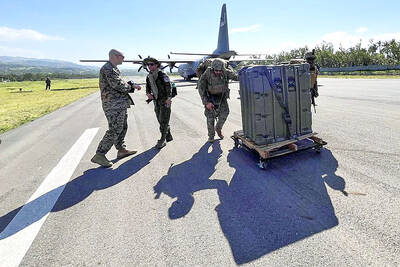Overtime work hours continued to decline last year, while more people reported feeling satisfied with their jobs than in 2022, a Ministry of Labor report found on Monday.
About 41 percent of people worked overtime last year for an average of 13.4 hours per month, continuing a downward trend in recent years and falling 0.8 percentage points from 2022, the ministry’s annual survey on employment conditions showed.
The electricity and gas industries had the most overtime with 63.1 percent of those surveyed in the sectors saying they worked extra hours.

Photo: CNA
More than half of those working in public service, national defense, transportation, healthcare and social work said they worked overtime.
Last year, 84.6 percent of those who worked overtime said they were paid extra or given makeup days, an increase of 0.5 percentage points from the year before.
The real-estate industry was the worst at providing overtime compensation, with 19.6 percent saying they were not given extra pay or other time off.
It was followed by the publishing, audio-visual and communications industries at 16.4 percent, and retail at 12.9 percent.
Employers requesting extra work after hours remained a problem, with 24.5 percent of employees saying their bosses had contacted them after clocking out, although it was down 0.7 percentage points from 2022.
About 17 percent said they had to complete a task immediately, 5.1 percent returned to the office and 13.4 percent did the work elsewhere, averaging to about four hours per month.
However, 74.6 percent of those surveyed said they were satisfied with their jobs overall, up 1.2 percentage points from 2022. Only 3 percent said they were not satisfied.
Nearly all those who said they were satisfied cited gender equality as a reason (97.3 percent), followed by workplace friendships (96.1 percent) and workspace (94 percent).
The top three reasons cited by those who were dissatisfied were review and promotion systems (82.6 percent), wages (64.3 percent) and compliant mechanisms (60 percent).
The latest survey was conducted from June to July last year, and collected 4,095 valid responses.

Three batches of banana sauce imported from the Philippines were intercepted at the border after they were found to contain the banned industrial dye Orange G, the Food and Drug Administration (FDA) said yesterday. From today through Sept. 2 next year, all seasoning sauces from the Philippines are to be subject to the FDA’s strictest border inspection, meaning 100 percent testing for illegal dyes before entry is allowed, it said in a statement. Orange G is an industrial coloring agent that is not permitted for food use in Taiwan or internationally, said Cheng Wei-chih (鄭維智), head of the FDA’s Northern Center for

LOOKING NORTH: The base would enhance the military’s awareness of activities in the Bashi Channel, which China Coast Guard ships have been frequenting, an expert said The Philippine Navy on Thursday last week inaugurated a forward operating base in the country’s northern most province of Batanes, which at 185km from Taiwan would be strategically important in a military conflict in the Taiwan Strait. The Philippine Daily Inquirer quoted Northern Luzon Command Commander Lieutenant General Fernyl Buca as saying that the base in Mahatao would bolster the country’s northern defenses and response capabilities. The base is also a response to the “irregular presence this month of armed” of China Coast Guard vessels frequenting the Bashi Channel in the Luzon Strait just south of Taiwan, the paper reported, citing a

UNDER PRESSURE: The report cited numerous events that have happened this year to show increased coercion from China, such as military drills and legal threats The Chinese Communist Party (CCP) aims to reinforce its “one China” principle and the idea that Taiwan belongs to the People’s Republic of China by hosting celebratory events this year for the 80th anniversary of the end of World War II, the “retrocession” of Taiwan and the establishment of the UN, the Mainland Affairs Council (MAC) said in its latest report to the Legislative Yuan. Taking advantage of the significant anniversaries, Chinese officials are attempting to assert China’s sovereignty over Taiwan through interviews with international news media and cross-strait exchange events, the report said. Beijing intends to reinforce its “one China” principle

A total lunar eclipse, an astronomical event often referred to as a “blood moon,” would be visible to sky watchers in Taiwan starting just before midnight on Sunday night, the Taipei Astronomical Museum said. The phenomenon is also called “blood moon” due to the reddish-orange hue it takes on as the Earth passes directly between the sun and the moon, completely blocking direct sunlight from reaching the lunar surface. The only light is refracted by the Earth’s atmosphere, and its red wavelengths are bent toward the moon, illuminating it in a dramatic crimson light. Describing the event as the most important astronomical phenomenon